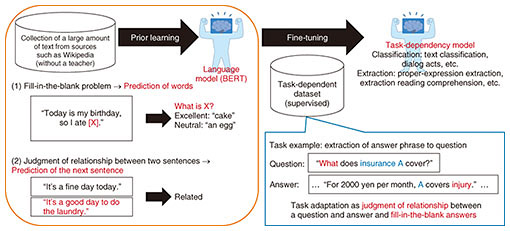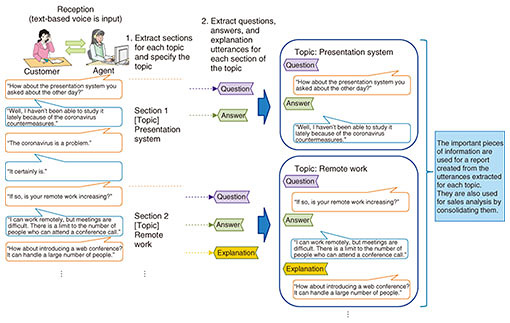 |
|||||||||||||||||||||
|
|
|||||||||||||||||||||
|
Feature Articles: Media-processing Technologies for Artificial Intelligence to Support and Substitute Human Activities Vol. 18, No. 12, pp. 59–63, Dec. 2020. https://doi.org/10.53829/ntr202012fa9 Knowledge and Language-processing Technology that Supports and Substitutes Customer-contact WorkAbstractAt NTT Media Intelligence Laboratories, using natural-language-processing technology cultivated over many years as one of our core competences, we are researching and developing knowledge and language-processing technology that contributes to improving the productivity of contact centers and offices. In this article, a language model, document-summarization technology, and interview-support technology are introduced. Keywords: AI, document summarization, response analysis 1. IntroductionAt NTT Media Intelligence Laboratories, we have researched and developed knowledge and language-processing technology for contact centers for analyzing documents (such as work manuals and frequently asked questions) and presenting appropriate documents to agents handling customers. Not only in contact centers but also in offices, it is necessary to further improve productivity of agents and employees. In response to this necessity, we are developing technology for understanding and generating large-scale documents and various responses. We first explain a language model for handling documents and document-summarization technology using this language model then describe interview-support technology for analyzing responses between a customer and agent. 2. Development of natural-language understanding by using a language model (BERT)It has been considered difficult for artificial intelligence (AI) to understand human language. However, with the advent of Bidirectional Encoder Representations from Transformers (BERT) [1], announced by Google in October 2018, the research and development (R&D) of natural-language understanding has undergone a large paradigm shift. For example, regarding the task called machine reading [2], which requires reading comprehension to understand the content of text and answer questions, it has been reported that AI using BERT greatly exceeded the response score of a human. Performance of natural-language-processing tasks other than machine reading has also improved significantly, and language models are attracting attention as a basic technology for giving AI the ability of language comprehension. A language model estimates the plausibility of sentences (Fig. 1). For example, many people may feel that “cake” is more natural than “egg” as the word “X” in the sentence “Today is my birthday, so I ate [X].” Also, it seems natural that the two sentences “It’s a fine day today.” and “It’s a good day to do the laundry.” appear consecutively. BERT learns in advance such fill-in-the-blank problems (word prediction) and relationships between two consecutive sentences (prediction of the next sentence) on the basis of a large set of texts such as all Wikipedia sentences. By learning (fine-tuning) with various task-dependent datasets, the language model (BERT) obtained in this manner can be applied to various tasks (such as classifying texts by genre and extracting phrases that will answer questions) and achieve high performance even when a large amount of learning data is not available for the applied task.
BERT has had a great impact on natural-language processing, and language models are still being researched and constructed all over the world. At NTT Media Intelligence Laboratories, while collecting a large amount of Japanese text data and creating a Japanese-language BERT, we are researching technologies that use language models for tasks such as summarizing documents [3, 4], retrieving documents [5], and answering questions [6, 7]. In each case, high performance is achieved by not only simply applying BERT but also using the knowledge we have gained through our previous research on natural-language processing and deep learning. Moreover, by investigating the characteristics and internal operation of BERT [8], we are researching with the aim of constructing our own language model that remedies the shortcomings of BERT. 3. Document-summarization technology for summarizing documents by specifying lengthDocument-summarization technology is introduced as a representative example of a technology that uses the language model described above. Document summarization has been grappled with for many years. For customer-contact work such as at contact centers, if AI returns a long sentence as a result of searching previous calls and answering a customer’s question, it will be difficult for the customer to read such a long sentence; accordingly, it is desirable to appropriately adjust the length of the sentence. Given the above-mentioned issue, NTT Media Intelligence Laboratories developed a document-summarization technology that can control sentence length by using a neural network [3]. This technology consists of a combination of an extractive model (which identifies important points in a sentence) and abstractive model (which generates a summary sentence from the original sentence). The extractive model learns on the basis of the language model. By controlling the number of important words output by the extractive model according to the specified sentence length and by generating a summary sentence based on both the important words and the original sentence, it was possible to establish a technology that can control sentence length and summarize with high accuracy. This document-summarization technology is used as the core engine of the COTOHATM API summarization function developed by NTT Communications [9]. COTOHA Summarize offers a service for outputting a summary text when a document is input and provides our customers a free tool for generating summary texts of sites browsed with a web browser. We plan to further develop this technology for the NTT Group. We will continue to advance R&D to improve this summarization technology, which includes not only document summarization but also summarization that targets dialogue and summarization that allows the viewpoint and keywords of the summarization to be specified externally. To further strengthen the competitiveness of our language model, we plan to continue technological development while incorporating the results of our latest research on language processing. Such work will include scaling up the model, constructing a generative language model for generating more-natural sentences, and establishing summarization technology based on that model [4]. 4. Technology for using knowledge obtained from contact-center calls4.1 Challenges in supporting customer contactsNTT Media Intelligence Laboratories developed an automatic knowledge assistance system [10]. This is a technology that automatically retrieves and presents documents according to the content of a conversation with a customer. By supporting the agent with knowledge and responding promptly to customers with appropriate information, it became possible to improve relationships with customers. However, contact centers are required to play a new role as the business style changes due to the digital transformation (DX) of offices and the spread of the novel coronavirus. One of these roles is as a sales method called inside sales. Inside sales is explained as follows. In contrast to the conventional sales method, namely, a full-time salesperson conducts face-to-face sales to understand customer needs and conclude business negotiations, inside sales is based on (i) maintaining continuous communication with the other party while gathering information (such as understanding needs) that triggers business negotiations via telephone or web conference and (ii) dispatching a salesperson when the possibility of receiving an order or contract increases. The number of contact centers that handle customers by using inside sales is increasing. The challenges facing contact centers playing this role are as follows.
4.2 Interview-support technologyTo address the above-mentioned challenges, we developed interview-support technology. This technology consists of two elements (Fig. 2). The first specifies a series of responses to the customer for each section of the topic. The second extracts important utterances such as questions, answers, and explanations from the sections specified by the former.
A characteristic of a business conversation that draws out issues and requests concerning a customer is that the topic continuously changes according to the answers given by the customer. Since conventional technology cannot cope with such a dynamic situation, we developed a means of firmly determining the point at which the topic changes. This is the first feature of the interview-support technology. Sections of the same topic are specified by machine learning using characteristic expressions at the point of change of the topic appearing in a conversation, and the type of topic is acquired by machine learning using characteristic expressions in the topic. The second feature of this technology is that the utterances of questions and answers of agents and customers for each topic are extracted by machine learning using characteristic expressions included in important utterances such as questions and answers. By using the text of a call that is divided into sections for each topic by using the interview-support technology, after the call, the agent can quickly identify the points at which he/she heard about the customer’s needs and budget and create a report based on that information. Moreover, by collecting such information from many calls, it becomes possible to support the analysis of sales information. We aim to apply this technology to responses via voice but also via online chat (text messages), which has been increasing in popularity. 5. Concluding remarksWe introduced our language model, document-summarization technology, and interview-support technology. Going forward, we plan to work on two technologies for understanding and generating large-scale documents and various responses: (i) a technology that can read various document layouts and search for necessary information at high speed and high accuracy and (ii) a technology that supports strategic conversations by grasping the details of a conversation and extracting needs that customers may have difficulty noticing themselves. References
|
|||||||||||||||||||||







